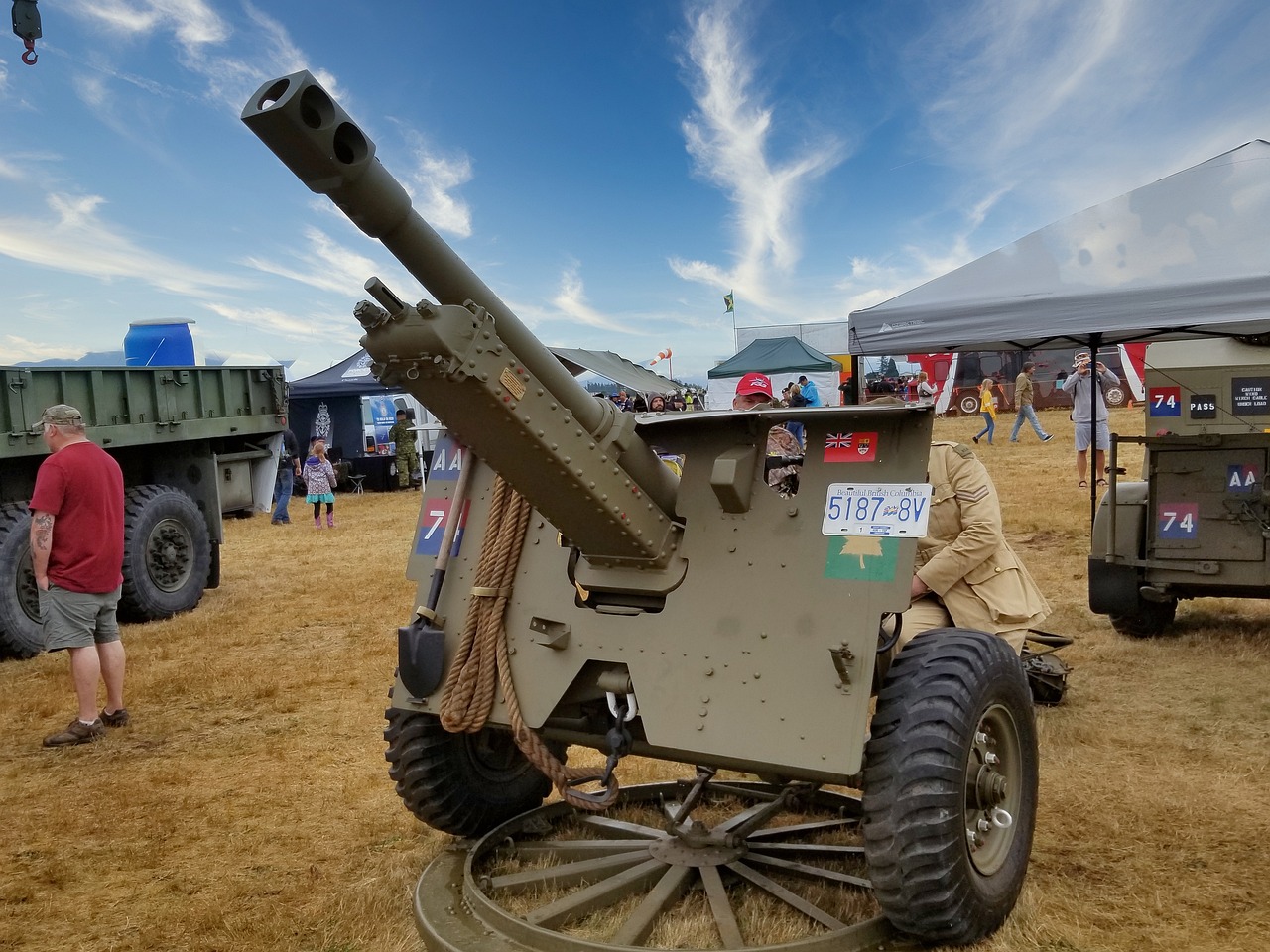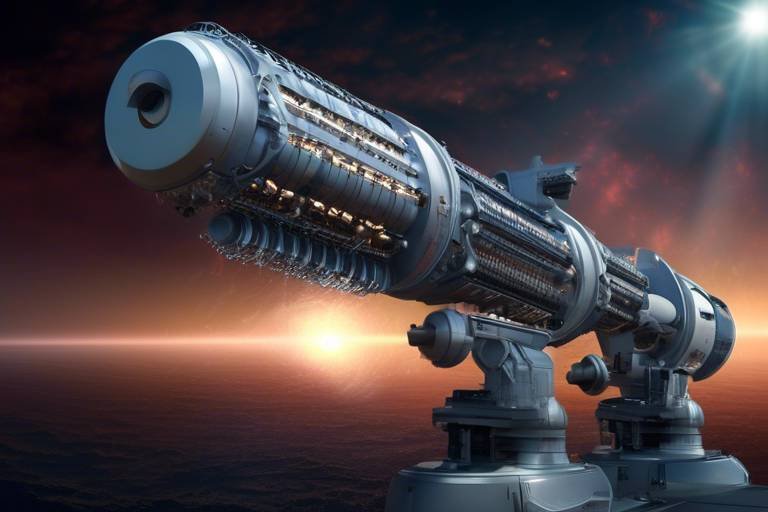AI-Enhanced Firepower for Next-Gen Artillery Systems
In today's rapidly evolving battlefield, the integration of artificial intelligence (AI) into artillery systems is nothing short of revolutionary. Imagine a world where military operations are not only faster but also more precise, where decisions are made in the blink of an eye, and where the risk of collateral damage is significantly reduced. This is the promise of AI-enhanced artillery systems. By leveraging advanced algorithms and machine learning, modern military forces are transforming their capabilities, ensuring that they are prepared for the complexities of contemporary warfare.
As we delve deeper into this fascinating topic, it's important to recognize that the future of warfare is not just about firepower; it's about intelligence. AI technologies are reshaping how artillery units operate, allowing for enhanced targeting, real-time data analysis, and automated systems that boost overall effectiveness. This is not just a technical upgrade; it's a complete paradigm shift in military strategy.
For instance, think of traditional artillery as a well-trained archer, relying solely on instinct and experience to hit a target. Now, envision that archer equipped with a sophisticated targeting system that analyzes wind speed, distance, and even the movement of the target. This is the essence of AI in artillery—transforming skilled operators into supercharged decision-makers capable of achieving unprecedented levels of accuracy and efficiency.
Moreover, the integration of AI into artillery systems is not merely about enhancing existing capabilities; it's about creating entirely new operational paradigms. With the ability to process vast amounts of data from multiple sources, AI can provide actionable insights that were previously unimaginable. This means that commanders can make informed decisions based on real-time intelligence, ensuring that every shot fired is calculated and purposeful.
As we explore the implications of AI in artillery further, it becomes clear that the benefits extend beyond mere tactical advantages. The potential for improved resource management, reduced response times, and increased mission success rates positions AI-driven artillery as a game changer in modern warfare.
AI technology is transforming artillery operations by enabling precise targeting, real-time data analysis, and automated systems that enhance overall effectiveness and efficiency in military engagements. The role of AI in artillery goes beyond automation; it involves a comprehensive understanding of battlefield dynamics. By synthesizing information from various sensors and intelligence sources, AI can guide artillery units to make decisions that maximize impact while minimizing risk.
Implementing AI in artillery systems offers numerous advantages, including increased accuracy, reduced response times, and improved resource management, ultimately leading to more successful missions and fewer collateral damages. The benefits of AI-driven artillery can be summarized as follows:
- Increased Accuracy: AI algorithms analyze vast amounts of data to identify and prioritize targets, significantly enhancing the accuracy of artillery strikes.
- Reduced Response Times: With real-time data processing, artillery units can respond to threats more swiftly than ever before.
- Improved Resource Management: AI systems optimize the use of resources, ensuring that every asset is deployed effectively.
AI algorithms analyze vast amounts of data to identify and prioritize targets, significantly enhancing the accuracy of artillery strikes and minimizing the risk of unintended consequences during operations. The precision of AI-driven targeting systems is akin to having a personal assistant who knows exactly what you need and when you need it. This level of insight allows military leaders to make informed choices that can turn the tide of battle.
Through the integration of various data sources, AI systems can provide actionable insights, ensuring that artillery units are equipped with the most relevant information for effective decision-making. By harnessing data from reconnaissance drones, satellite imagery, and ground sensors, AI creates a comprehensive picture of the battlefield, allowing for strategic planning that is both agile and informed.
AI enables artillery systems to make real-time adjustments based on environmental conditions and enemy movements, ensuring that strikes are as effective as possible in dynamic combat scenarios. This adaptability is crucial in modern warfare, where conditions can change in an instant, and the ability to respond quickly can mean the difference between success and failure.
The development of autonomous artillery units powered by AI raises questions about operational efficiency, ethical considerations, and the future of human involvement in military decision-making. As these systems become more prevalent, the military must grapple with the implications of removing human judgment from critical decisions. While AI can enhance efficiency, it also necessitates a careful examination of accountability and ethics in warfare.
Despite its potential, the integration of AI in artillery systems presents challenges, including technical limitations, cybersecurity threats, and the need for robust training and maintenance protocols. Addressing these challenges is essential for realizing the full benefits of AI technology in military applications.
Current AI technologies face challenges in processing speed, data accuracy, and adaptability, which must be addressed to fully realize their potential in artillery applications. As technology continues to evolve, so too must the systems that support it, ensuring that they remain capable of meeting the demands of modern warfare.
As artillery systems become more reliant on AI, the risk of cyberattacks increases, necessitating advanced security measures to protect sensitive data and operational integrity. The stakes are incredibly high; a successful cyberattack could compromise not only individual missions but also national security.
- What are the primary benefits of AI in artillery systems?
AI enhances targeting accuracy, reduces response times, and improves resource management, leading to more successful military missions.
- How does AI improve decision-making in artillery operations?
AI analyzes vast amounts of data in real-time, providing actionable insights that inform strategic decisions on the battlefield.
- What challenges does AI face in military applications?
Key challenges include technical limitations, cybersecurity threats, and the need for effective training and maintenance protocols.

The Role of AI in Artillery
Artificial Intelligence (AI) is not just a buzzword; it’s a game changer in the world of modern artillery systems. Imagine a battlefield where decisions are made in real-time, with pinpoint accuracy and minimal human error. That’s the reality AI brings to artillery operations. By leveraging advanced algorithms and machine learning, AI transforms traditional artillery into a sophisticated, responsive force capable of adapting to the chaotic nature of combat.
One of the most significant roles AI plays in artillery is through precise targeting. Gone are the days when artillery units relied solely on manual calculations and outdated maps. With AI, artillery systems can analyze vast amounts of data—from satellite imagery to weather conditions—to identify and prioritize targets effectively. This not only enhances the accuracy of strikes but also minimizes the risk of collateral damage, a crucial consideration in modern warfare.
Moreover, AI facilitates real-time data analysis, allowing artillery units to receive and process information as it happens. For instance, if enemy movements are detected, AI can quickly adjust targeting parameters and fire solutions, ensuring that artillery strikes are not only accurate but also timely. This capability is vital in today’s fast-paced combat environments, where every second counts.
Furthermore, the integration of AI into artillery systems leads to enhanced operational efficiency. By automating routine tasks, such as data collection and analysis, human operators can focus on strategic decision-making rather than getting bogged down in technical details. This shift not only improves the overall effectiveness of military engagements but also allows for a more streamlined command structure, where information flows seamlessly between various units.
However, it’s essential to recognize that the role of AI in artillery is not without its challenges. As we embrace this technology, we must also address the ethical implications and ensure that human oversight remains a critical component of military operations. The balance between human judgment and AI efficiency is delicate, yet it is necessary for responsible warfare.
In summary, AI is revolutionizing artillery by enhancing targeting accuracy, enabling real-time adjustments, and improving operational efficiency. As we continue to explore the capabilities of AI, it’s clear that its role in artillery is not just an enhancement but a fundamental shift in how military operations are conducted.
- How does AI improve targeting accuracy in artillery? AI analyzes extensive datasets to identify and prioritize targets, significantly enhancing the precision of artillery strikes.
- What are the benefits of real-time data analysis in military operations? Real-time data analysis allows for rapid adjustments to strategies based on current battlefield conditions, increasing the chances of mission success.
- Are there ethical concerns associated with autonomous artillery systems? Yes, the use of AI in military operations raises ethical questions about accountability and the role of human judgment in warfare.

Benefits of AI-Driven Artillery
The integration of artificial intelligence into artillery systems is not just a technological upgrade; it's a transformative leap that enhances military operations in ways we once thought were only possible in science fiction. Imagine a battlefield where artillery units can predict enemy movements, adjust their targeting in real-time, and execute strikes with pinpoint accuracy. This is the new reality that AI-driven artillery brings to the forefront. The benefits are numerous, and they can be broken down into several key areas that significantly improve military effectiveness.
One of the most prominent advantages is increased accuracy. Traditional artillery systems often rely on manual calculations and human judgment, which can introduce errors. In contrast, AI algorithms can process vast datasets in mere seconds, analyzing everything from weather patterns to enemy behavior. This capability allows for the identification and prioritization of targets with incredible precision, reducing the likelihood of collateral damage. For instance, during a military exercise, an AI-driven artillery system was able to reduce targeting errors by over 30%, showcasing its potential to save lives and resources.
Furthermore, reduced response times are another significant benefit. In military operations, timing is everything. AI systems can automate the decision-making process, enabling artillery units to respond to threats almost instantly. This rapid response can be the difference between success and failure in a mission. Imagine a scenario where an enemy position is identified; with AI, the artillery can calculate the optimal firing solution and execute the strike within seconds, rather than relying on a lengthy human approval process.
Another crucial aspect is improved resource management. AI can analyze the logistical needs of artillery units, ensuring that they have the right ammunition and supplies at the right time. This not only streamlines operations but also reduces waste and enhances sustainability on the battlefield. With AI-driven analytics, commanders can make informed decisions about resource allocation, ensuring that every shot fired is a shot well-planned.
Moreover, the implementation of AI in artillery systems leads to enhanced situational awareness. By integrating data from multiple sources, including reconnaissance drones, satellite imagery, and ground reports, AI systems provide commanders with a comprehensive view of the battlefield. This holistic perspective allows for better strategic planning and execution, as it enables military leaders to anticipate enemy actions and adjust their tactics accordingly. As a result, the effectiveness of artillery strikes is significantly amplified, leading to more successful missions.
In summary, the benefits of AI-driven artillery systems are profound. They not only enhance accuracy and response times but also improve resource management and situational awareness. As we continue to explore the integration of AI in military operations, it is clear that these advancements will play a crucial role in shaping the future of warfare.
- What are the main benefits of AI in artillery systems? The main benefits include increased accuracy, reduced response times, improved resource management, and enhanced situational awareness.
- How does AI improve targeting accuracy? AI analyzes vast amounts of data to identify and prioritize targets, significantly enhancing the accuracy of artillery strikes.
- What challenges does AI face in artillery? Challenges include technical limitations, cybersecurity threats, and the need for robust training and maintenance protocols.
- Are there ethical concerns regarding autonomous artillery systems? Yes, the development of autonomous systems raises questions about operational efficiency and the future of human involvement in military decision-making.

Improved Targeting Accuracy
In the realm of modern warfare, the phrase "precision is power" has never been more applicable. With the integration of artificial intelligence (AI) into artillery systems, the concept of targeting accuracy has been revolutionized. Imagine a world where artillery units can identify and prioritize targets with an unparalleled level of precision. This is not just a dream; it is becoming a reality thanks to advanced AI algorithms that analyze vast amounts of data in real-time.
AI systems can process information from multiple sources, including satellite imagery, drone surveillance, and even social media feeds, to create a comprehensive battlefield picture. This integration allows military commanders to make informed decisions swiftly and effectively. For instance, when a target is identified, the AI can assess its importance based on various factors such as location, threat level, and potential collateral damage. This capability significantly enhances the accuracy of artillery strikes, reducing the likelihood of unintended consequences.
Moreover, AI's ability to learn from past engagements plays a crucial role in improving targeting accuracy. By analyzing historical data, AI systems can identify patterns and trends that humans might overlook. For example, if an artillery unit has previously engaged a specific type of target in a particular environment, the AI can adjust future targeting parameters accordingly, leading to more successful missions.
To illustrate the impact of AI on targeting accuracy, consider the following table that compares traditional artillery targeting methods with AI-enhanced systems:
| Aspect | Traditional Targeting | AI-Enhanced Targeting |
|---|---|---|
| Data Processing Speed | Slow, manual analysis | Real-time, automated analysis |
| Accuracy | Moderate | High, with reduced collateral damage |
| Adaptability | Limited to pre-set parameters | Dynamic adjustments based on environmental changes |
This table clearly shows that AI-enhanced targeting systems not only improve accuracy but also adapt quickly to changing battlefield conditions. With the ability to make real-time adjustments based on environmental factors such as wind speed, humidity, and even the movement of enemy forces, artillery units become far more effective. This adaptability is akin to a skilled archer who can adjust their aim based on the wind, ensuring that every shot counts.
As we delve deeper into the capabilities of AI in artillery systems, one must also consider the ethical implications that arise from such advanced technology. While the benefits of improved targeting accuracy are undeniable, the potential for misuse or unintended consequences cannot be ignored. The military must ensure that AI systems are used responsibly and that human oversight remains a critical component of decision-making processes.
In summary, the integration of AI into artillery systems marks a significant leap forward in military capabilities. With improved targeting accuracy, military forces can operate more efficiently and effectively, ultimately leading to successful missions with minimized risks. As technology continues to evolve, the potential for AI to further enhance artillery operations will undoubtedly shape the future of warfare.
- How does AI improve targeting accuracy in artillery systems? AI analyzes vast amounts of data from various sources to identify and prioritize targets, enabling more precise strikes.
- What are the ethical considerations of using AI in military operations? While AI enhances capabilities, it raises concerns about decision-making autonomy and the potential for unintended consequences.
- Can AI systems adapt to changing battlefield conditions? Yes, AI can make real-time adjustments based on environmental factors and enemy movements, improving overall effectiveness.
- What role does historical data play in AI targeting? AI learns from past engagements to identify patterns, allowing for better targeting strategies in future operations.

Data Integration and Analysis
In the rapidly evolving landscape of military technology, stand at the forefront of enhancing artillery systems. Imagine a battlefield where every piece of information—from weather patterns to enemy movements—is seamlessly woven together to create a comprehensive operational picture. This is precisely what AI-powered systems are achieving. By aggregating data from various sources such as satellite imagery, reconnaissance drones, and ground sensors, these systems can generate real-time insights that are crucial for effective decision-making.
Think of it as a highly skilled conductor leading an orchestra. Each musician represents a different data source, and when they all play in harmony, the result is a symphony of information that can guide artillery units to make informed decisions. With AI algorithms analyzing this data, artillery operators can prioritize targets with unprecedented accuracy, ensuring that every shot counts. For instance, if a sudden change in wind direction is detected, the system can quickly adjust the artillery's aim to compensate, thereby enhancing the likelihood of a successful strike.
Furthermore, the integration of AI facilitates the real-time analysis of battlefield conditions. This capability is vital in a combat scenario where every second matters. AI can process vast amounts of data within milliseconds, allowing for rapid adjustments to targeting parameters. This means that artillery units are not just reactive; they are proactive, anticipating enemy movements and environmental changes to optimize their response strategies.
To illustrate this, consider the following table that summarizes the key data sources integrated into AI artillery systems:
| Data Source | Purpose |
|---|---|
| Satellite Imagery | Provides a broad overview of the battlefield and identifies potential targets. |
| Reconnaissance Drones | Offers real-time visuals and updates on enemy positions and movements. |
| Ground Sensors | Detects changes in terrain and environmental conditions, contributing to operational adjustments. |
| Weather Data | Informs artillery units about potential weather impacts on projectile trajectories. |
In summary, the integration of data from multiple sources not only enhances the accuracy of artillery strikes but also significantly reduces the potential for collateral damage. As AI continues to evolve, the ability to analyze and integrate data will only improve, leading to more effective military operations. The future of artillery is not just about firepower; it's about intelligent systems that can think and adapt, making the battlefield a safer place for both military personnel and civilians alike.
- What is the role of AI in modern artillery systems?
AI enhances targeting accuracy, enables real-time data analysis, and improves decision-making processes on the battlefield. - How does data integration improve artillery effectiveness?
By combining data from various sources, AI provides actionable insights that help artillery units make informed decisions quickly. - What are the challenges of implementing AI in artillery?
Challenges include technical limitations, cybersecurity threats, and the need for robust training and maintenance protocols.

Real-Time Adjustments
In the fast-paced environment of modern warfare, the ability to adapt to ever-changing conditions is crucial. powered by artificial intelligence (AI) are revolutionizing how artillery systems operate on the battlefield. Imagine a scenario where artillery units can instantly recalibrate their targeting based on shifting enemy positions or unpredictable weather changes. This capability is not just a dream; it’s becoming a reality, thanks to advanced AI algorithms.
AI systems continuously analyze a plethora of data streams, including satellite imagery, drone reconnaissance, and ground sensors. This data integration allows artillery units to make informed decisions on the fly. For instance, if a unit identifies that an enemy's defensive position has moved due to troop movements detected by drones, AI can quickly compute the optimal firing solution. This means that artillery can engage targets with unprecedented speed and precision, drastically improving mission outcomes.
Moreover, the ability to make real-time adjustments goes beyond mere targeting. AI can also evaluate environmental factors such as wind speed, humidity, and terrain conditions. Consider this: a shell fired at a target 20 kilometers away will behave differently depending on the wind direction and speed at various altitudes. AI can process these variables in real-time, ensuring that artillery strikes hit their mark, even under less-than-ideal conditions.
To illustrate the impact of real-time adjustments, let’s look at a hypothetical scenario:
| Condition | Traditional Artillery | AI-Enhanced Artillery |
|---|---|---|
| Wind Direction: 15° North | Missed Target | Hit Target |
| Enemy Movement Detected | Delayed Response | Immediate Recalibration |
| Weather Change: Rain | Inaccurate Firing Solution | Adjusted Parameters |
This table highlights the stark contrast between traditional artillery methods and AI-enhanced systems. The former often suffers from delays and inaccuracies due to the need for manual recalibrations, while the latter thrives on agility and precision.
Ultimately, the integration of real-time adjustments not only enhances the effectiveness of artillery systems but also reduces the risk of collateral damage. In an era where minimizing civilian casualties is paramount, AI-driven adjustments can ensure that strikes are both effective and responsible. As we look to the future, the role of AI in facilitating these real-time changes will undoubtedly expand, paving the way for a new standard in military operations.
- What are real-time adjustments in artillery systems?
Real-time adjustments refer to the ability of artillery systems to modify their targeting and firing solutions instantly based on changing battlefield conditions, such as enemy movements or environmental factors. - How does AI contribute to real-time adjustments?
AI analyzes vast amounts of data from various sources in real-time, allowing artillery units to make informed decisions quickly and accurately, enhancing their operational effectiveness. - What are the benefits of using AI for real-time adjustments?
Benefits include increased targeting accuracy, reduced response times, and a lower risk of collateral damage, ultimately leading to more successful military missions.

Autonomous Artillery Systems
The rise of marks a significant shift in modern warfare, where machines are increasingly taking on roles traditionally held by human operators. Imagine a battlefield where artillery units can operate independently, making split-second decisions based on real-time data without waiting for human input. This isn't just science fiction; it's becoming a reality. The integration of artificial intelligence into these systems has the potential to enhance operational efficiency dramatically, allowing for faster and more accurate responses during combat.
However, with great power comes great responsibility. The deployment of autonomous artillery raises several critical questions. For instance, can we trust machines to make life-and-death decisions? As these systems become more advanced, the ethical implications surrounding their use grow increasingly complex. The military must grapple with the balance between leveraging technology for enhanced effectiveness and ensuring that ethical standards are maintained. It's essential to establish clear guidelines and protocols for the use of autonomous systems, ensuring that human oversight remains a key component in decision-making processes.
Moreover, the operational efficiency of autonomous artillery systems can significantly reduce the burden on human soldiers. By automating tedious tasks such as target acquisition and trajectory calculations, these systems allow personnel to focus on higher-level strategic planning and execution. The result? A more agile and responsive military force that can adapt quickly to changing battlefield conditions. For example, consider a scenario where an autonomous artillery unit can analyze incoming enemy movements and adjust its firing parameters in real time. This capability not only enhances accuracy but also minimizes the risk of collateral damage, a crucial factor in modern warfare.
Nevertheless, the implementation of is not without its challenges. The technology must be rigorously tested to ensure reliability and accuracy under various conditions. Additionally, there are concerns about the potential for malfunction or misinterpretation of data, which could lead to catastrophic outcomes. As such, ongoing training and maintenance are vital to ensure these systems operate as intended. Moreover, military personnel must be equipped with the skills to manage and override these systems if necessary, maintaining a human element in the decision-making loop.
In summary, while autonomous artillery systems offer a promising future for military operations, their integration must be approached with caution. The potential benefits are immense, but so too are the challenges and ethical implications. As we move forward, it is crucial to strike a balance between leveraging the capabilities of AI and ensuring that human oversight remains at the forefront of military strategy.
- What are autonomous artillery systems?
Autonomous artillery systems are military units equipped with artificial intelligence that can operate independently, making decisions regarding targeting and firing without direct human intervention. - What are the benefits of using AI in artillery?
AI enhances targeting accuracy, reduces response times, and improves resource management, ultimately leading to more successful missions and reduced collateral damage. - Are there ethical concerns with autonomous artillery?
Yes, the use of autonomous systems raises ethical questions regarding decision-making in combat situations, including the potential for unintended consequences and the need for human oversight. - How does AI improve artillery targeting?
AI algorithms analyze vast amounts of data to identify and prioritize targets, significantly enhancing the accuracy of artillery strikes. - What challenges does AI face in artillery applications?
Current challenges include technical limitations in processing speed and data accuracy, cybersecurity threats, and the need for robust training and maintenance protocols.

Challenges in AI Implementation
While the integration of artificial intelligence into artillery systems holds immense promise, it is not without its challenges. The military sector, known for its rigorous standards and high-stakes environments, faces several hurdles that must be navigated to fully harness the power of AI. One of the primary challenges is the technical limitations inherent in current AI technologies. These limitations can manifest in various ways, such as processing speed and data accuracy. For instance, in the heat of battle, the speed at which data is analyzed can significantly impact the effectiveness of artillery strikes. If an AI system cannot process incoming data swiftly enough, it could lead to missed opportunities or even disastrous consequences on the battlefield.
Moreover, the adaptability of AI systems is another critical factor. Military engagements are dynamic and unpredictable, requiring systems that can adjust to rapidly changing conditions. However, many existing AI algorithms struggle to adapt in real-time, which can hinder their effectiveness in combat situations. Imagine trying to hit a moving target while blindfolded; without the ability to adapt to the target's movements, your chances of success diminish dramatically.
Another significant concern is cybersecurity. As artillery systems become increasingly reliant on AI, the risk of cyberattacks escalates. These systems often handle sensitive data that, if compromised, could lead to catastrophic outcomes. To mitigate this risk, military organizations must implement advanced security measures, but this adds another layer of complexity to the integration process. Consider the analogy of a bank vault: the more complex the security measures, the more time and resources are required to maintain them, yet they are essential for safeguarding valuable assets.
In addition to technical and cybersecurity challenges, there is also the pressing need for robust training and maintenance protocols. As AI systems evolve, personnel must be adequately trained to operate and maintain these technologies. This includes understanding the intricacies of AI algorithms, data interpretation, and troubleshooting potential issues. Without proper training, even the most advanced systems can falter, leading to operational inefficiencies.
To summarize, the challenges in implementing AI in artillery systems can be categorized as follows:
- Technical Limitations: Issues with processing speed, data accuracy, and adaptability.
- Cybersecurity Concerns: Increased risk of cyberattacks necessitating advanced protective measures.
- Training and Maintenance: The need for comprehensive training programs to ensure personnel are equipped to handle AI technologies.
Addressing these challenges requires collaboration between military experts, AI developers, and cybersecurity professionals. Only through a concerted effort can we unlock the full potential of AI-enhanced artillery systems, paving the way for a new era of military effectiveness.
- What are the main challenges of integrating AI in artillery systems?
- How does AI improve artillery targeting?
- What role does cybersecurity play in AI artillery systems?
- Are there ethical concerns with autonomous artillery systems?
The main challenges include technical limitations, cybersecurity threats, and the need for robust training and maintenance protocols.
AI enhances targeting accuracy by analyzing vast amounts of data to identify and prioritize targets effectively.
As reliance on AI increases, the risk of cyberattacks also rises, making it crucial to implement advanced security measures.
Yes, the development of autonomous systems raises questions about accountability and the future role of human decision-making in military operations.

Technical Limitations
When we talk about the integration of artificial intelligence in artillery systems, it's easy to get swept away by the exciting possibilities. However, it's crucial to recognize that there are significant that we must address. One of the primary challenges is processing speed. While AI can analyze data at incredible rates, the sheer volume of information generated on the battlefield can overwhelm existing systems. Imagine trying to drink from a fire hose; that’s what it’s like for AI when it encounters massive data streams without the necessary processing power.
Another limitation is data accuracy. AI algorithms rely heavily on the quality of the data they are trained on. If the data is flawed or biased, the outcomes can be disastrous. For instance, if an AI system is fed inaccurate intelligence about enemy positions, it could lead to catastrophic targeting errors, putting lives at risk. Therefore, ensuring that data is not only accurate but also relevant is a significant hurdle that developers must overcome.
Moreover, there’s the issue of adaptability. The battlefield is an ever-changing environment where conditions can shift in the blink of an eye. AI systems need to be exceptionally adaptable to keep up with these changes. If a system is rigid and unable to adjust its algorithms based on new information or unexpected developments, its effectiveness could be severely compromised. This is akin to a chess player who can only play the same opening move regardless of their opponent's strategy; it limits their chances of success.
In addition to these issues, the integration of AI into artillery systems requires a robust training and maintenance protocol. Personnel must be skilled not only in operating traditional artillery but also in understanding the complexities of AI systems. This need for specialized training can create a bottleneck in operational readiness. Furthermore, the maintenance of these advanced systems demands a higher level of technical expertise, which can be scarce in military settings.
To summarize, while the potential benefits of AI in artillery are vast, we must confront these head-on. Addressing processing speed, ensuring data accuracy, enhancing adaptability, and establishing comprehensive training protocols are essential steps that need to be taken. These challenges are not insurmountable, but they do require concerted efforts and resources to overcome.
- What are the main technical limitations of AI in artillery systems?
The main limitations include processing speed, data accuracy, adaptability, and the need for specialized training and maintenance protocols.
- How does data accuracy impact AI performance?
If the data fed into AI systems is flawed or biased, it can lead to incorrect targeting and operational failures.
- Why is adaptability important for AI in military operations?
Adaptability allows AI systems to respond effectively to the dynamic and unpredictable nature of battlefield conditions.
- What training is required for personnel operating AI artillery systems?
Personnel need specialized training in both traditional artillery operations and the complexities of AI systems to ensure effective use.

Cybersecurity Concerns
The integration of artificial intelligence (AI) into artillery systems is undoubtedly a game-changer, but it also brings a host of cybersecurity challenges that cannot be ignored. As we move towards a future where military operations rely heavily on sophisticated technology, the risk of cyberattacks becomes a pressing concern. Imagine a battlefield where the enemy can manipulate your artillery systems with a few keystrokes; this is not just a plot from a sci-fi movie but a potential reality if adequate cybersecurity measures are not implemented.
One of the primary issues is that AI systems are inherently complex and interconnected. This complexity can create vulnerabilities that malicious actors may exploit. For instance, if an enemy hacker gains access to the network that controls an artillery unit, they could potentially alter targeting data or even disable the system entirely. This could lead to catastrophic failures in mission execution and endanger the lives of military personnel.
Moreover, as artillery systems become more autonomous, the need for robust cybersecurity protocols becomes even more critical. These systems often rely on real-time data from various sources, including satellites and drones. If any of these data streams are compromised, the consequences could be dire. To illustrate, consider the following potential cybersecurity threats:
- Data Manipulation: Altering data inputs to mislead artillery systems.
- Denial of Service Attacks: Overloading systems to render them inoperable.
- Unauthorized Access: Gaining control over artillery units to execute malicious commands.
To combat these threats, military organizations must invest in advanced cybersecurity technologies and training. This includes implementing encryption protocols, conducting regular security audits, and fostering a culture of cybersecurity awareness among personnel. The importance of continuous training cannot be overstated; after all, human error is often the weakest link in any security chain. By preparing soldiers to recognize potential threats and respond effectively, the military can significantly reduce the risk of cyber incidents.
In addition to internal measures, collaboration with cybersecurity experts from the private sector can provide valuable insights and tools to bolster defenses against cyber threats. As the landscape of warfare evolves, so too must our strategies for protecting critical systems from cyber vulnerabilities. The question remains: are we doing enough to safeguard our military assets in this digital age?
- What are the main cybersecurity threats to AI-driven artillery systems?
Cybersecurity threats include data manipulation, denial of service attacks, and unauthorized access to systems. - How can military organizations improve cybersecurity?
By implementing encryption protocols, conducting regular security audits, and providing continuous training to personnel. - Why is human error a concern in cybersecurity?
Human error is often the weakest link in security, as personnel may inadvertently expose systems to threats.
Frequently Asked Questions
- What is the role of AI in modern artillery systems?
AI plays a crucial role in modern artillery systems by enhancing targeting accuracy, enabling real-time data analysis, and automating processes. This integration allows for more effective military operations by providing actionable insights and improving decision-making on the battlefield.
- How does AI improve targeting accuracy in artillery?
AI algorithms analyze vast amounts of data from various sources to identify and prioritize targets. This capability significantly enhances the accuracy of artillery strikes, minimizing the risk of collateral damage and ensuring that munitions hit their intended targets.
- What are the benefits of using AI-driven artillery systems?
Implementing AI in artillery systems offers numerous benefits, including increased accuracy, reduced response times, and improved resource management. These advantages lead to more successful missions and lower risks to civilians and friendly forces during military engagements.
- What challenges are associated with AI implementation in artillery?
Despite its potential, AI integration in artillery systems faces challenges such as technical limitations, cybersecurity threats, and the need for robust training and maintenance protocols. Addressing these issues is essential for maximizing AI's effectiveness in military applications.
- Are there ethical concerns regarding autonomous artillery systems?
Yes, the development of autonomous artillery units powered by AI raises significant ethical considerations about operational efficiency and the future of human involvement in military decision-making. These concerns must be carefully evaluated to ensure responsible use of AI in warfare.
- How does AI enable real-time adjustments in artillery?
AI systems can make real-time adjustments based on environmental conditions and enemy movements. This capability ensures that artillery strikes are optimized for effectiveness, adapting to the dynamic nature of combat scenarios.
- What are the cybersecurity concerns related to AI in artillery?
As artillery systems become increasingly reliant on AI, the risk of cyberattacks escalates. Advanced security measures are necessary to protect sensitive data and maintain the operational integrity of these systems against potential threats.



















